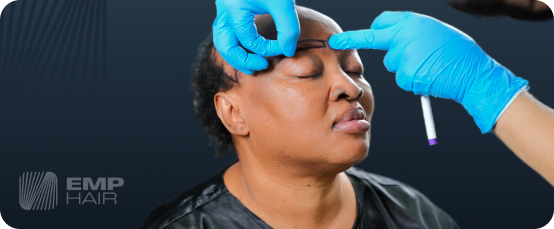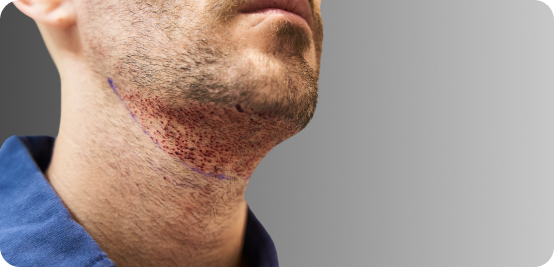
What is Beard and Eyebrow Transplantation?
One of the most important details that determine the character of the face is the beard and eyebrows. Due to genetic factors, hormonal disorders, traumas or skin diseases in the past, beard or eyebrow area may become sparse or completely absent. This can become an aesthetic problem that damages self-confidence, especially for beards in men and lack of eyebrows in women and men.
Beard and eyebrow transplantation are microsurgical procedures that give permanent and natural results by placing hair follicles taken from the donor area (usually the nape of the neck) at natural angles and directions in areas with sparse or no growth. Thanks to these applications made with modern techniques, naturalness is preserved, facial expression is strengthened and the individual's self-confidence is regained.
Table of Contents

Reclaim What Belongs to Your Face
“For years I have felt like a child, not a teenager, because I haven't grown a beard...”
In society, the beard is seen as a symbol of masculinity, maturity and character. A man without a beard can be perceived as “incomplete” or “young”, even if he doesn't want to be. This can make itself felt especially in social settings, job interviews or even when choosing a partner. Instead of shaving every morning, just looking at a blank jawline in the mirror... Saying “I wish I had that” at every glance... Beard transplantation is not just an aesthetic application, but a solution that visibly fills this gap. Moreover, thanks to the application made with your own hair follicles in accordance with the natural growth direction, you can replace the part that has been missing on your face for years without anyone noticing.
“I plucked my eyebrows too much, now my face looks expressionless and tired...”
Thin eyebrows, once in fashion, are now a cause for regret... Not being able to go out without makeup, “completing” your face with eyebrow pencil first thing in the morning... And perhaps worst of all: “I can't look like my real self”. Eyebrow transplantation offers a permanent and natural solution to this anxiety. Since the individually placed hair follicles are designed according to the face shape and facial expression, the eyebrows look like your own eyebrows after the procedure. Now, instead of the same makeup routine every morning, you can start the day by saying “I am ready”.
"There is a gap in part of my beard. I feel as if I have a wound on my face."
Accidents, burns, acne scars or congenital local deficiencies... Maybe others don't even notice it, but every time you look in the mirror, you see that gap. And this deficiency is not just a spot; sometimes it turns into a shadow that affects your entire facial expression. Local beard and eyebrow transplantation restores aesthetic integrity in exactly such cases. When the roots are placed at a natural angle, that area is closed and you smile not only on your face but also on your soul when you look in the mirror.
“Why do people talk about beards so much? I don't even want to talk about it...”
If you are someone who withdraws in social situations because you don't have a beard, who is uncomfortable with jokes or whose self-confidence is damaged... Know that you are not alone. This condition is very common and many people continue to live with this discomfort for years because they postpone the solution. But now there are technological and comfortable solutions. Thanks to beard and eyebrow transplantation, you can effortlessly leave this problem behind without explaining it to anyone.
It's not just a hair that's missing from your face. It can be a sense of wholeness, an expression, a posture. And this can be regained.
“I haven't even shaved for years because my beard won't grow...”
For some men, a beard is not just a hair, but a part of masculinity, maturity, even identity. Many individuals who look younger than their age and feel incomplete because they don't grow a beard are afraid to even talk about it. However, this is now changing. With beard transplantation, you can get the facial line you have been dreaming of for years.
“I had my eyebrows plucked years ago, they never grew back...”
Eyebrows that were once over-plucked for the sake of fashion can permanently disappear. This situation hardens the facial expression of women and affects the posture without makeup. Thanks to eyebrow transplantation, you can regain the natural, characteristic expression you were born with.
“I can't grow a beard where there is a scar, it bothers me a lot.”
Beard and eyebrow transplantation is also possible for local deficiencies after accidents, burns or surgical interventions. With the roots taken from the donor area, that area can be restored to its natural appearance. Highlight your self-confidence, not the scars on your face.

Beard and Eyebrow Transplant Process
Preliminary Analysis and Planning
- Donor site density is checked (usually the nape of the neck)
- Planning is done by drawing sparse or empty areas
- Eyebrow / beard line is designed according to the face structure
- Hair directions and frequency are calculated
- Suitability for local anesthesia is assessed
Operation Day
- Local anesthesia is applied
- Grafts (hair follicles) are taken with a micro motor
- Micro channels are opened in the beard or eyebrow area
- Roots are placed one by one at a natural angle
- Especially for eyebrows, the principle of 1 direction → 1 root is used
- The procedure takes 2-5 hours on average
- Discharged on the same day
Postoperative Period
- First 3 days: Redness and edema may occur. Avoid contact and washing with water.
- Day 5-10: Crusts start and fall off spontaneously.
- Day 15: Most of the transplanted hairs fall out (shock shedding).
- 2-3 Months: New beard/eyebrow hairs start to grow.
- 6 Months - 1 Year: Density increases, full result is achieved.
Frequently Asked Questions (FAQ)
